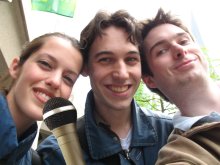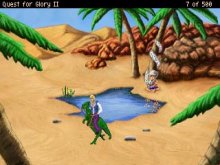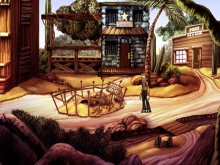- Interviews
- Britney Brimhall & Stijn van Empel (Englisch)
Interviews
Britney Brimhall & Stijn van Empel (Englisch)
Gesprächspartner: Jan 'DasJan' Schneider
Sprache: 
Vom:
29.06.2006
Über
Britney Brimhall founded Tierra Entertainment (now AGD Interactive) several years ago to remake some Sierra classics. Stijn van Empel was originally community member and then moderator for the fan adventure developer, but now also plays a role in the development of the current project Quest for Glory II VGA. Britney will soon publish her first commercial project Al Emmo she developed with her company Himalaya Studios.
Adventure-Treff: "Since you are not anonymous anymore, please introduce yourself to our readers."
Britney Brimhall: "My name is Britney Brimhall, also known as Anonymous Game Developer #1, and the company cofounder is Chris Warren, also known as Anonymous Game Developer #2."
AGD Interactive
A-T: "Tell us about the beginnings of Tierra Entertainment, which is now known as AGD Interactive. You started with a never released parody, right?"
Britney: "That’s right. Chris and I had been working on another game development project, and we felt the progress was too slow and were losing motivation. We decided to take a short break from that project and work on our own. We hoped by doing this, and finishing our own project, we would regain the motivation necessary to continue working on “the never ending project” .
I had a friend in college who was also a huge fan of adventure games, and he brought up the idea of working on a King’s Quest I parody. We felt that King’s Quest was a small game and would take us a few weeks to finish, tops. How wrong we were! It took us about 9 months of non-stop work to complete development on the game.
During the course of making the game, my college friend dropped out of the project, and we decided to remain true to the Sierra spirit and make a one-to-one remake of the classic."
A-T: "How did you assemble the team while remaining anonymous?"
Britney: "Like I mentioned, Chris and I had met on another project, so we were already friends from the get go. Daniel Stacey, our designer for King’s Quest II VGA, was actually a fan who sent us a great story proposal. This won him a spot on the team. As for our music department, we were already impressed with Tom Lewandowski’s work over at Quest Studios. We noticed on his forums, he mentioned the poor quality of our music, and wished that he could do something about it. We wished he could, too, so we asked him to join our team!
Basically, a lot of our workers started out as fans, and proved through a lot of dedication, and by showing off their work, that they deserved a spot on the development team."
A-T: "Why did you decide to stay anonymous in the beginning?"
Britney: "When we started creating Sierra remakes, we never planned on releasing them to the public. By the time we were finished with our first project, we realized that other people would probably enjoy playing it, since it had turned out a lot better than we’d ever anticipated! We didn’t want our efforts overshadowing the work of the original designers, and felt they still deserved the recognition for the games. Therefore, we decided to stay anonymous. We only started using our real names as we branched off into completely original projects."
A-T: "How did you get the idea to remake King's Quest I?"
Britney: "As I mentioned earlier, King’s Quest I was a means for us to regain motivation to continue working on another fan project. We started out making a parody, but over time, realized that we felt better about releasing a game that paid homage to the great Sierra classics instead of poking fun at them. Therefore, we continued with and released a one-to-one remake of the original King’s Quest game."
A-T: "King's Quest II+, your second published game, was not just a remake, it was a largely expanded version of the original game. Why this?"
Britney: "It was the next logical step in the game development process. We had proven we could make a one-to-one remake, and we wanted to expand on these skills. Additionally, a lot of fans explained that they wanted something new. King’s Quest II offered a perfect opportunity to expand on the original story, because many people felt it was inherently lacking. By adding additional elements to the classic, people were able to get their “Sierra fix”, but also play a release that was both new and exciting."
A-T: "What techniques do you use to recreate the specific Sierra art style."
Britney: "Sketching a background concept on paper, scanning it, coloring it using a WACOM tablet in Photoshop, and resizing it to low resolution works wonders when creating classic style game art."
A-T: "Did you have any games in production which were never released?"
Britney: "Yes, for some time, years ago, we were working on a VGA version of Space Quest II. For various reasons, we had to cancel it though. After we had announced its cancellation, we released what had been completed in the form of a three room demo."

Quest for Glory II VGA
A-T: "Your next remake will be Quest for Glory II VGA. When do you plan to release it?"
Stijn van Empel: "When it's finished and properly beta tested. We're afraid we cannot give exact estimations. We've been trying to give those, only to come up short and disappoint people. We're not too far off now anymore though."
A-T: "Is your version true to the original, like KQ I VGA, or did you extend it again?"
Stijn: "Yes and no. QFG II VGA is not merely the original version with VGA graphics replacing the old 16 color art and nothing more. We occasionally took the liberty to add some gimmicks here and there to make the game more enjoyable to players. But we made sure not to touch the storyline or dialogues though; in that aspect, QFG II VGA is still very much the Trial by Fire that was released so many years ago."
A-T: "Can you tell us something about those gimmicks?"
Stijn: "A noteworthy addition is the inclusion of a storage chest in the hero's room to hold items that would otherwise just weight the player down. Other additions simply provide a few extra opportunities for a player to spend his time and money."
A-T: "You met Lori & Corey Cole a while ago. How was it for you as a long time fan to meet them in person and what did they say about your project?"
Stijn: "We gave them a demonstration on our laptop and from what we could tell, they liked what they saw. For us, it was like visiting Santa Claus at his North Pole home. It was one of the most exciting experiences of our life and it was wonderful meeting the people whom we've considered heroes for quite some time."
A-T: "Did you get feedback from other developers of the original games?"
Stijn: "We had the opportunity to speak with Brian K. Hughes, a programmer for the original QFG II, about a certain aspect of the game that never made it in the original. We've also spoken to various other ex-Sierra employees in the past."
A-T: "And what did they say?"
Stijn: "They used to tell us about how life was at Sierra. Sierra wasn't exactly the magic kingdom we envisioned it to be when first playing the classics. But it pointed out to us the work and hardships behind the games we grew to enjoy."
A-T: "How large is QfG II VGA compared to your earlier remakes?"
Stijn: "Technically speaking, A LOT larger. KQ I VGA was very straight-forward in structure and so was KQ II VGA, despite its enhanced storyline. QFG II VGA contains many things that didn't exist in our earlier remakes and had to be recreated from scratch in AGS, the engine we're using. A lot of work went into setting up things like the statistics system, the day/night system, the battle system, the bargaining system and much, much more. It's a lot of work to keep track of everything, and because of its complicated structure, the game is like 10 times more bug-prone than any of the other projects."
A-T: "How long did you need to finish your remakes?"
Stijn: "For KQ I VGA, it took about 9 months and KQ II VGA took slightly over a year. QFG II VGA was started on before KQ II VGA was released, but the "basic template" that was made back then wasn't really touched much until the game was officially picked up again around May 2003. Three years have passed between the basic template-mode and the full-fledged RPG/adventure mode."

General questions
A-T: "You use AGS as your engine. Why do you prefer this engine?"
Britney: "We prefer to use AGS because it is already feature intensive and the creator of the engine, Chris Jones, continually adds even more features that are ever so useful to developing our games. Chris Jones appears to have the same work ethic as we do, and has been amazingly helpful to us from the beginning, so we of course want to support his work and offer our loyalty."
A-T: "Many underground adventure developers are too ambitious and never finish their projects. You will soon release your third game, being even bigger than the other ones. What is your secret?"
Britney: "I think we were lucky to “start small”. We realized, even starting with a small game, that is was much larger than we had ever anticipated. Therefore, we realized from the very beginning what our limits were. The first game pushed us out of our comfort zone—we had to work hard to complete that game. We understood at that point what we were capable of, and also realized we could finish a game with enough hard work. We could then set new goals from there. It’s like running. You have to start with a mile. Once you reach that point with ease, you can continue to increase the distance. Soon, you’ll be running a marathon without trouble. For us, we started with a small remake, worked up to an expanded remake, advanced to a large adventure/role-playing game hybrid remake, and also a completely original title with 3D character sprites, professional voice-overs, lip synching and more!"
A-T: "You started without an official license, but today you have an agreement with Vivendi. How are your experiences with their legal department?"
Britney: "They’ve been friendly, but being a huge corporation with a lot of different interests, they of course don’t have a lot of time to spare. Communication between our development team and the legal department can involve a lot of waiting."
A-T: "If Vivendi would ask you to work for them and create games in the classic style, what would you say?"
Britney: "If it was a game that we believed in, we would definitely be up for the challenge."
A-T: "What's the best part of making games and what's the worst?"
Britney: "The best part of making games is the creative outlet, seeing your dreams come to fruition, and working in a team. The worst part of making games is creating more assets that you thought was humanly possible, and knowing that a lot of them won’t even make it into the game, or that they will have to be redone again, and again, and again. This can lead to burnout. There have literally been days that I’ve sat at my computer, incoherently mumbling, “no, no more artwork…no more. Please, no more.” But once all the assets are finished, those less than fond memories are replaced with enthusiasm once again. I imagine the process is similar to having a baby (not that I’d really know)—conception is good, the labor is God awful, and after the release, it’s a beautiful and inspiring moment."
A-T: "One might think you only like Sierra games. What do you think about other adventure games, like the ones from LucasArts or more recent ones?"
Britney: "I grew up on the Sierra classics, although many members of our team grew up on the Lucas Arts classics. The general consensus on the team is, we like them all! I’ve played parts of the Monkey Island games, and the humor was fantastic. I’ve played parts of the more recent games as well, such as Syberia and the Longest Journey. It is harder for me to get involved in these games, due to the lack of strong interaction with the environment or innovative interfaces, but once I delve into the storyline, I am equally as mesmerized. I played the Longest Journey in German, at a time I didn’t speak much of it, and the game was good enough to keep me glued to the screen. But even with all these new games, I must admit, I still crave classic style adventure games—I think there is still a place for games that are created in the traditional style."

Al Emmo and the Lost Dutchman's Mine
A-T: "In 2002 you started your own commercial company Himalaya Studios. Did you form a new team for that or was it the same group who did the Sierra remakes?"
Britney: "We basically invited our most dedicated, proven workers from the Sierra remakes to work on Al Emmo. In addition, we scouted out additional workers with skills in the areas of 3D modeling and animation, business expertise, and voice acting."
A-T: "Is it different to create a commercial game than creating fan adventures?"
Britney: "Definitely. It appears it is easier to motivate team members to work on remakes, because they already have positive feelings associated with those games and have a set template to follow. Additionally, with a commercial title, we feel the need to offer even more than we do with our remakes. We’ve taken a lot of time to add details like lip synching, extensive 3D cutscenes, professional voice-overs including narration, high-resolution graphics and more."
A-T: "How did you manage two projects, QfG II VGA and Al Emmo, simultaneous?"
Britney: "We had two separate teams, with only a little bit of worker overlap. I was responsible for making about 60 dialogue portraits and quite a few animations for the QFG II VGA remake, as well as some backgrounds; I tried to get those out of the way early, so I could then concentrate on our commercial release. Now, every so often, I’ll get a request for some artwork edits on the QFG II VGA project, and I just try to schedule that in during my “relaxation time” after working on Al Emmo."
A-T: "Your team is quite international and grew pretty much over the years. How do you manage such a team efficently?"
Britney: "Most of the workers on the team are very responsible and self sufficient. You can give them a task, and they will basically go and finish what was asked of them. They are very skilled as well, so you can pretty much expect to receive great work the first time around. If they are asked to make edits, they do so without complaining. We’ve been lucky to have mature and easy to work with teammates."
A-T: "You already gave us a sneak peak of the game, so our readers can get an impression by reading our preview (here). What were your inspirations for Al Emmo and the Lost Dutchman's Mine and why did you decide to do the western setting?"
Britney: "At the time I initially came up with the idea for Al Emmo, I was actually living abroad in Germany, and was a bit homesick. Growing up in the desert of Arizona, I received a lot of inspiration for the game from my childhood experiences! The game is more than a typical Western — in a way, parts of it are an autobiography of my life (minus anything involving the hospitality house)!"
A-T: "You mean: you are Al Emmo?!"
Britney: "How did you guess?! Oh wait, no. Al Emmo was actually based a bit off of a German teacher I had in school, although his personality changed greatly as the story was refined. Chris seems to believe he has a lot in common with Al Emmo now.
As for other autobiographical elements, none of the events are exactly parallel to my life, but there are similarities. For instance, Rita has long brown hair, grew up in the desert, and lost her father. Koko the Pharmacist has a fascination with blueberry muffins and crazy business plans, just like my sister's ex boyfriend. Kevin the Bartender is an Englishman who serves drinks to the town locals, just like the Kevin who served me coffee everyday in Germany. There is even a dastardly and mysterious Bubba character who has played a role in my life!"
A-T: "What are your experiences with publishers when talking about the distribution of your game?"
Britney: "We’ve received a lot of interest from a variety of different publishers. We’ve also had a lot of interest from different publishers wanting to localize the game into other languages. We may eventually follow this route. We were always interested in publishing the game on our own though, and doing our own marketing, so unless there was an amazing deal that we just couldn’t pass up, we want to face the challenge of releasing the game ourselves at this point. It’s been a great learning experience."
A-T: "So a German version of Al Emmo is possible?"
Britney: "Definitely a possibility!"
A-T: "Your game will most likely not conquer the mass market but stay more or less within the adventure community. Do you see a commercial future for the genre?"
Britney: "At one time, there was a large enough market to keep the adventure genre flourishing. That market is still around, even if these gamers aren’t reading the most popular gaming magazines or visiting game stores. It is not as easy to reach this market by traditional means, but I do see a commercial future for the genre, since people who love the classics are still out there and reading about games online and hearing about them from their friends."
A-T: "Al Emmo will be released very soon, Quest for Glory II VGA is nearing completion, too, and there is no new product announced. So what are you all doing next?"
Britney: "Daniel Stacey has created a preliminary design for a new game, which looks fantastic, but we will wait and see how Al Emmo is received before dedicating ourselves to any future projects. If the game is not well received, then we will probably finish up work on Quest for Glory II VGA and then concentrate on outside professions for a while. So, the future of classic style adventure games really does heavily depend on the fan support. "
A-T: "Thanks a lot for taking the time to answer our questions. I wish you a lot of success with your games and your future plans."
Britney: "Thank you! By the way, I would like to mention, if you have a MySpace account, please add Al Emmo as your friend. Also, please join us at our forums to celebrate the upcoming release of Al Emmo and the Lost Dutchman’s Mine!"
Links
- Al Emmo preview (German)
- Al Emmo Homepage
- Al Emmo Demo
- Himalaya Studios
- AGD Interactive
Aktuelle Artikel
![]()
Unterstützen
![]()
Adventure-Treff-Verein
IBAN: DE38 8306 5408 0004 7212 25
BIC: GENODEF1SLR
Bitte beachtet, dass wir leider keine steuerrechtlich anrechenbare Spendenquittungen ausstellen können.
Mit jedem Einkauf bei unseren Partnern unterstützt ihr die Arbeit des Adventure-Treff e.V.












